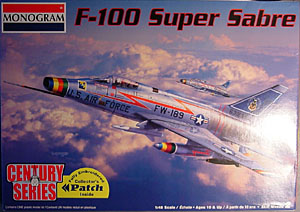Monogram's 1/48
F-100D Super Sabre | | History The North American F-100 Super Sabre was an evolution North American's famous F-86 Sabre that encompassed many of the lessons learned in the air war over Korea and added that significant new capability in combat aircraft - supersonic cruise speeds in level flight. Some of the problems faced by Sabre pilots over Korea included a lack of speed superiority to overtake a fleeing MiG-15 and the limited range/punch with the 50 caliber machine guns that armed these aircraft. At this stage in Sabre development, none of the fighter versions had been equipped with afterburing engines (the heavier F-86 Sabre Dogs would be the first recipient of the thrust augmenting afterburner technology). While the F-86H would come along after the war with 20mm cannons and an afterburner, it still suffered from enough drag to limit its supersonic flight to steep dives and with safety limitations. A new airframe was required and the results of this redesign became the F-100 or 'Hun' for short. The F-100A was an interim step in the development of the USAF's first operational supersonic aircraft. This version saw major changes in design, including an enlarged vertical stabilizer, to work out the bugs in stability, reliability and performance. The F-100B would later be re-designated as the F-107A and was designed to adapt the F-100 to the long-range nuclear strike mission. The F-100C would be the first truly operational version of the Hun family, though production quickly transitioned to the improved and most widely produced version - the F-100D. The F-100D incorporated a new wing that added trailing edge flaps for improved low-speed performance, an improved engine, modified speed brakes to allow their use with a store on the centerline pylon, and an offset tail hook to allow for the mounting of the zero-length launch rocket motor. While the mounts were on all F-100Ds, the 'feature' was not used outside of the test world. 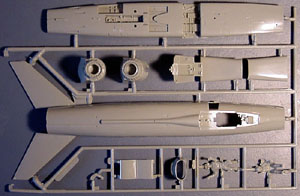 When war broke out in Southeast Asia, the F-100Ds were deployed to provide air superiority over the skies of Vietnam much like the F-86s did over Korea. Unfortunately, the lack of radar rendered the F-100s ineffective as air-to-air machines and the Hun was relegated to air-to-ground duties. In this capacity, the Hun excelled for a while, but its age began to show against the newer aircraft entering service. The F-100D would serve in numerous air forces around the world and many ended their careers as target drones for missile testing and/or training. When war broke out in Southeast Asia, the F-100Ds were deployed to provide air superiority over the skies of Vietnam much like the F-86s did over Korea. Unfortunately, the lack of radar rendered the F-100s ineffective as air-to-air machines and the Hun was relegated to air-to-ground duties. In this capacity, the Hun excelled for a while, but its age began to show against the newer aircraft entering service. The F-100D would serve in numerous air forces around the world and many ended their careers as target drones for missile testing and/or training.
The Kit How old is this kit? Well, if you were born the year this kit came out, you could legally purchase alcohol in the US. 1980 is the date etched in the wings, and the molds show it. There's some flash around some of the smaller parts (most notably the instrument panel), but for the most part the kit looks much like it did 21 years ago. As was typical for Monogram kits of that era, all the panel lines are raised, with a fair amount of rivets scattered around. The plastic in this release is very shiny, a result of Monogram polishing up and cleaning the molds. It's a pity they couldn't have gone a step further and recessed the panel lines as well. Even with raised lines, though, this is still the best 1/48 F-100 out there. 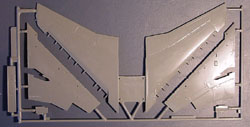 When Monogram engineered this kit, they did it in a rather unique way, with the fuselage split into an upper half and a lower half, with the upper wing being one piece trapped between the two halves. This puts the fuselage seam down the sides where it's fairly easy to fix, rather than down the centerline (which on the bottom would be a challenge to clean up without destroying a lot of detail). When Monogram engineered this kit, they did it in a rather unique way, with the fuselage split into an upper half and a lower half, with the upper wing being one piece trapped between the two halves. This puts the fuselage seam down the sides where it's fairly easy to fix, rather than down the centerline (which on the bottom would be a challenge to clean up without destroying a lot of detail).
The piles of pieces to go inside the fuselage offer quite a bit of detail, especially for such an old kit. The cockpit tub is attached to the upper half of the intake duct, with a separate piece for the lower half. This, combined with the one-piece nose will result in a nice-looking intake. The cockpit detailing is all raised and does a decent job of showing what an F-100 cockpit looked like, and some careful drybrushing will pay off well here. The cockpit isn't the only innards provided, though, as the left side cannons are exposed, including the ammo storage below the canopy. The detailing here could probably use some added bits and pieces, but it definitely adds something different. Should you choose to not have these panels open, you'll probably have a bit of work in getting the hatches to fit flush, due to the age of the molds. 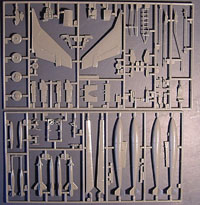 The vertical tail is a separate piece in this kit, and you get two styles of rear exhaust cones. A nice touch in this kit is the separate slats, but if you want to have the flaps dropped you'll have to do that yourself. The speed brake is separate, and all the wells (nose gear, main gear and speed brake) are all well detailed. The landing gear also is well done, with little missing. To hang under the wings you get a pair of drop tanks, a pair of Bullpup missiles, and a pair of Mk. 82 bombs. Two styles of refueling probes are included, and a ladder provides the last little detail. The vertical tail is a separate piece in this kit, and you get two styles of rear exhaust cones. A nice touch in this kit is the separate slats, but if you want to have the flaps dropped you'll have to do that yourself. The speed brake is separate, and all the wells (nose gear, main gear and speed brake) are all well detailed. The landing gear also is well done, with little missing. To hang under the wings you get a pair of drop tanks, a pair of Bullpup missiles, and a pair of Mk. 82 bombs. Two styles of refueling probes are included, and a ladder provides the last little detail.
The decals have changed frequently with this kit over the years, but I think this release has the best decals yet. You get two choices, both colorful and in natural metal finish. Time to use some of that new Alclad II here. The first example is from the 79th TFS, 20th TFW, based out of Woodbridge, Suffolk, England. The colors on this plane are predominately yellow, with a yellow lightning bold along the fuselage sides and another on the tail. The fuselage flash has the 79th TFS emblem centered on it, while the tail gets the 20th TFW emblem at the tip. The nose is also painted yellow. The rest of the markings are standard USAF stencilling. The second example is that seen on the boxtop, and it's a colorful one. This is a plane from the 31st TFW based out of George AFB in California. Most likely the mount of the Wing commander, this plane has blue, yellow, red and green stripes all over the place; on the nose, on the fuel tanks, covering the wing tips, and even on the speed brake. A red lightning bolt runs down the fuselage side and this is duplicated on the 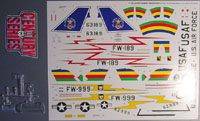 fuel tanks. The tail is blue, outlined in white, with a TAC Fighter Weapons Team emblem centered on it. The 31st TFW emblem is on the nose. There's a lot of decals for this scheme and careful application will pay off in the long run. The decals are thin and color density is excellent. These decals are a far leap forward from previous Monogram decals and they should be commended. fuel tanks. The tail is blue, outlined in white, with a TAC Fighter Weapons Team emblem centered on it. The 31st TFW emblem is on the nose. There's a lot of decals for this scheme and careful application will pay off in the long run. The decals are thin and color density is excellent. These decals are a far leap forward from previous Monogram decals and they should be commended. Conclusion While this is an old kit and will need some extra TLC, it will build up into a very nice replica of the F-100D. With your choices limited for 1/48 Huns, it's a good thing Monogram has re-released this old classic. The quality decals add a nice touch, so if you've run out of your old boxings of F-100s, definitely grab one of these while they're still available. Oh, and as an added bonus, you also get a Century Series patch. What more could you ask for? Our thanks to Revell-Monogram for the review sample. |


 




|
